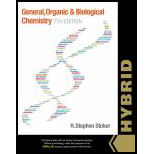
(a)
Interpretation:
Completion of the following table of information about selected ionic compounds.
Concept Introduction:
Chemical formulas and names for ionic compounds containing polyatomic ions:
Ionic compounds containing positive and negative charges present must add to zero.
If more than one polyatomic ion is present in a compound, the chemical formula can be written as a polyatomic ion is enclose in parentheses and a subscript, placed outside of the parentheses. Example-
Sometimes same element is present in two different locations. For example,
(a)
Answer to Problem 4.124EP
The completed table is as follows:
Explanation of Solution
The given name of the compound has
The dissociation of
From the above reaction,
Copper is a metal cation with
Hence, the compound name is Copper (I) sulfate.
Therefore, the completed table is shown below:
(b)
Interpretation:
Completion of the following table of information about selected ionic compounds.
Concept Introduction:
Chemical formulas and names for ionic compounds containing polyatomic ions:
Ionic compounds containing positive and negative charges present must add to zero.
If more than one polyatomic ion is present in a compound, the chemical formula can be written as a polyatomic ion is enclose in parentheses and a subscript, placed outside of the parentheses. Example-
Sometimes same element is present in two different locations. For example,
(b)
Answer to Problem 4.124EP
The completed table is as follows:
Explanation of Solution
The given compound name has Lithium nitride.
It indicates that compound has positive lithium ion
Therefore, the completed table is shown below:
(c)
Interpretation:
Completion of the following table of information about selected ionic compounds.
Concept Introduction:
Chemical formulas and names for ionic compounds containing polyatomic ions:
Ionic compounds containing positive and negative charges present must add to zero.
If more than one polyatomic ion is present in a compound, the chemical formula can be written as a polyatomic ion is enclose in parentheses and a subscript, placed outside of the parentheses. Example-
Sometimes same element is present in two different locations. For example,
(c)
Answer to Problem 4.124EP
The completed table is as follows:
Explanation of Solution
The ionic compound has positive aluminium ion
The name of the compound
Therefore, the completed table is shown below:
(d)
Interpretation:
Completion of the following table of information about selected ionic compounds.
Concept Introduction:
Chemical formulas and names for ionic compounds containing polyatomic ions:
Ionic compounds containing positive and negative charges present must add to zero.
If more than one polyatomic ion is present in a compound, the chemical formula can be written as a polyatomic ion is enclose in parentheses and a subscript, placed outside of the parentheses. Example-
Sometimes same element is present in two different locations. For example,
(d)
Answer to Problem 4.124EP
The completed table is as follows:
Explanation of Solution
The given name of the compound has
The dissociation of
From the above reaction,
Hence, the compound name is Cobalt (II) phosphate.
Therefore, the completed table is shown below:
Want to see more full solutions like this?
Chapter 4 Solutions
General, Organic, And Biological Chemistry, Hybrid (with Owlv2 Quick Prep For General Chemistry Printed Access Card)
- Write formulas for the following binary ionic compounds: a. mercury(I)oxide b. lead(II)oxide c. platinum(IV)iodide d. copper(I)nitride e. cobalt(II)sulfidearrow_forwardWrite chemical formulas for the following binary ionic compounds. a. Iron(III) oxide b. Iron(II) oxide c. Nickel(III) sulfide d. Copper(I) bromidearrow_forwardWrite chemical formulas for the following binary ionic compounds. a. Gallium nitride b. Zinc chloride c. Magnesium sulfide d. Aluminum nitridearrow_forward
- Distinguish between the following terms. a. molecule versus ion b. covalent bonding versus ionic bonding c. molecule versus compound d. anion versus cationarrow_forwardName each of the following binary ionic compounds. a. NiO b. FeN c. AlN d. BeOarrow_forwardHow many of the highlighted elements in the following periodic table have the valence electron characteristics listed below? a. Five valence electrons are present. b. One valence electron is present. c. Seven valence electrons are present. d. Two valence electrons are present.arrow_forward
- Predict the empirical formulas of the ionic compounds formed from the following pairs of elements. Name each compound. a. Li and N b. Ga and O c. Rb and Cl d. Ba and Sarrow_forwardPredict the empirical formulas of the ionic compounds formed from the following pairs of elements. Name each compound. a. AI and Cl b. Na and O c. Sr and F d. Ca and Searrow_forwardWrite the chemical formula for the ionic compound that would form from the elements X and Z if a. X has two valence electrons and Z has seven valence electrons b. X has one valence electron and Z has six valence electrons c. X has three valence electrons and Z has five valence electrons d. X has six valence electrons and Z has two valence electronsarrow_forward
 General, Organic, and Biological ChemistryChemistryISBN:9781285853918Author:H. Stephen StokerPublisher:Cengage Learning
General, Organic, and Biological ChemistryChemistryISBN:9781285853918Author:H. Stephen StokerPublisher:Cengage Learning World of Chemistry, 3rd editionChemistryISBN:9781133109655Author:Steven S. Zumdahl, Susan L. Zumdahl, Donald J. DeCostePublisher:Brooks / Cole / Cengage Learning
World of Chemistry, 3rd editionChemistryISBN:9781133109655Author:Steven S. Zumdahl, Susan L. Zumdahl, Donald J. DeCostePublisher:Brooks / Cole / Cengage Learning Introductory Chemistry: A FoundationChemistryISBN:9781337399425Author:Steven S. Zumdahl, Donald J. DeCostePublisher:Cengage Learning
Introductory Chemistry: A FoundationChemistryISBN:9781337399425Author:Steven S. Zumdahl, Donald J. DeCostePublisher:Cengage Learning Living By Chemistry: First Edition TextbookChemistryISBN:9781559539418Author:Angelica StacyPublisher:MAC HIGHER
Living By Chemistry: First Edition TextbookChemistryISBN:9781559539418Author:Angelica StacyPublisher:MAC HIGHER Chemistry for Today: General, Organic, and Bioche...ChemistryISBN:9781305960060Author:Spencer L. Seager, Michael R. Slabaugh, Maren S. HansenPublisher:Cengage Learning
Chemistry for Today: General, Organic, and Bioche...ChemistryISBN:9781305960060Author:Spencer L. Seager, Michael R. Slabaugh, Maren S. HansenPublisher:Cengage Learning General Chemistry - Standalone book (MindTap Cour...ChemistryISBN:9781305580343Author:Steven D. Gammon, Ebbing, Darrell Ebbing, Steven D., Darrell; Gammon, Darrell Ebbing; Steven D. Gammon, Darrell D.; Gammon, Ebbing; Steven D. Gammon; DarrellPublisher:Cengage Learning
General Chemistry - Standalone book (MindTap Cour...ChemistryISBN:9781305580343Author:Steven D. Gammon, Ebbing, Darrell Ebbing, Steven D., Darrell; Gammon, Darrell Ebbing; Steven D. Gammon, Darrell D.; Gammon, Ebbing; Steven D. Gammon; DarrellPublisher:Cengage Learning





